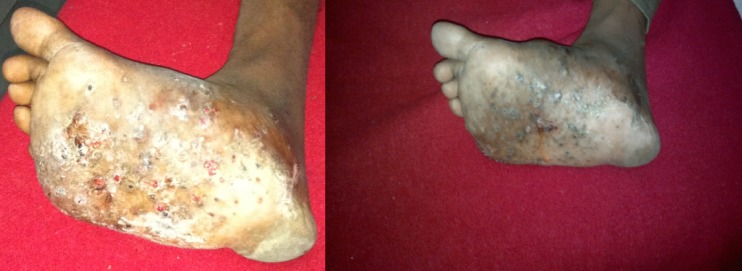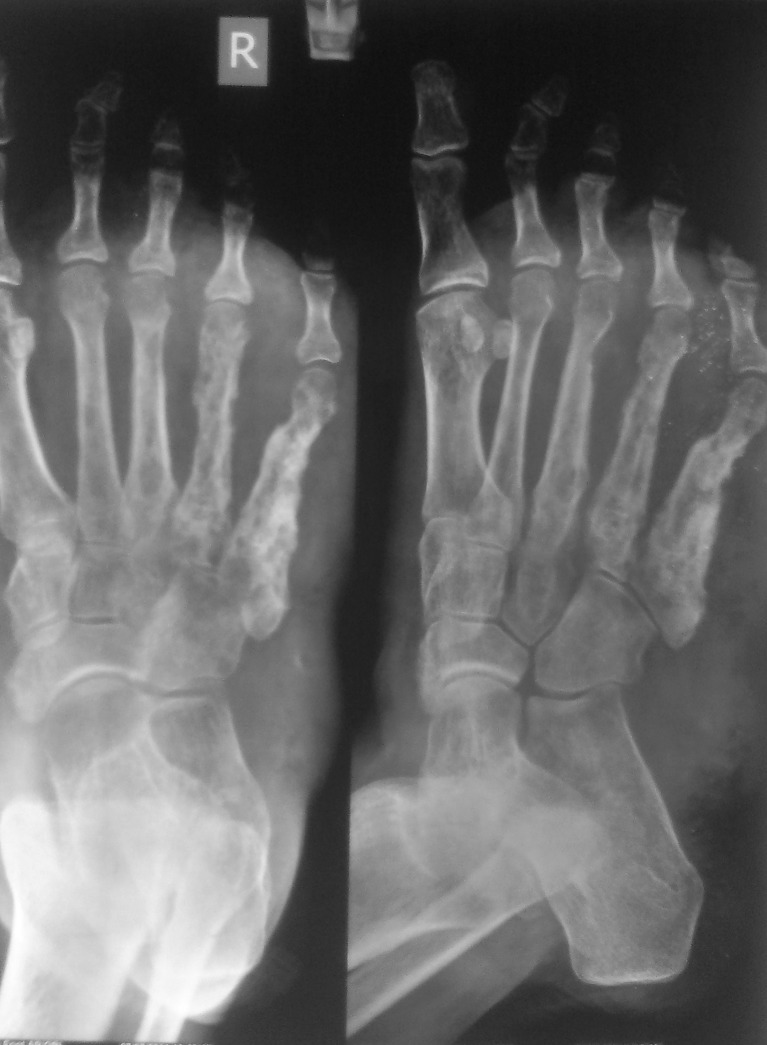Abstract
We describe a case of Actinomycetoma foot which presented to us after 3yrs of onset of symptoms.We have attempted a chemotherapeutic treatment regime and are reporting the healing changes that have taken place radiologically and macroscopically. A review of literature has been done of various treatment regimens used for Actinomycetoma foot and used and their practical applications in rural hospital.
Keywords: Fungal infection, Madhura foot, Actinomycosis, Actinomycetoma
Madura mycetoma is a chronic progressive granulomatous exogenous infection of skin, subcutaneous tissue, fascia, muscle, and occasionally the underlying bone and adjacent organs caused by heterogeneous infecting agents such as fungi, actinomycetes, and bacteria [1, 2]. It is more common in males, especially those in their third or fourth decade who work on the land. The clinical triad of subcutaneous nodule, sinuses, and discharge usually leads to diagnosis; the disease is commonly painless [3]. It is characterized by firm tumefaction of the affected site, with abscess, nodules, and sinuses that drain serosanguinous exudates containing filamentous granules.
Historically, the disease was recognized in 1842 by Gill while working in Madurai in India [4]. Carter [5] and Bidie [6] established the fungal etiology and named it mycetoma. The disease is endemic in the mycetoma belt between latitude 15 South and 30 North. Mycetomas are frequent in the tropical zones of Asia (India) [7–11], Africa (Senegal, Mauritius, and Sudan) [4, 14, 15] and America (Mexico, Brazil, Venezuela) [16, 17]. Madurella mycetomatis and Streptomyces somaliensis predominate in tropical parts of Africa and Asia. Nocardia brasiliensis and Actinomadura madurae commonly cause mycetoma in Mexico and South America.
Mycetoma is predominantly a disease of men in rural areas, who work bare foot on land such as farmers and daily labourers. Poor hygiene, low socioeconomic status, and low nutrition are the suggested risk factors. The causative agent that exists as saprophytes usually gains entry into the subcutaneous tissue through abrasions or implantation [4, 6, 8, 18, 19]. Infection begins in the skin and subcutaneous tissue causing local popular or nodular swelling that tends to grow and rupture, forming communicating sinus tracts through which grains are discharged. Grains vary from 0.2 to 3.0 mm in diameter and can be black, white, yellow, red, and pink depending on the causative organism [6, 9]. Some sinuses heal with scarring while fresh sinuses appear elsewhere, leading to enlargement and disfigurement of the affected limb (Fig. 1). Eventually destruction of the bone occurs when grains invade the cortical margins and replace the spongiosa [20]
Fig. 1.
Improvement in skin changes in mycetoma after treatment for 3 months
Two groups of mycetoma exist, eumycetoma caused by true fungi or mycetes and actinomycetoma caused by fungi-like aerobic bacteria from actinomycomysetes species.
The prevalence of actinomycetes is higher than that of eumycetes in South India, whereas the reverse is seen in North India [12, 13, 21–23].
Diagnosis
In early stages, mycetoma should be differentiated from various benign soft tissue tumors and in late stages from osteomyelitis due to pyogenic organisms.
Culture using deep tissue samples is carried out for fungi, bacteria, and actinomycetes in Sabouraud’s dextrose agar medium, blood agar, Lowenstein Jenson’s medium, and brain heart infusion agar medium.
Radiological examination: Local area X-ray as well as CT scan give details with regards to extent of involvement. The radiological features can be divided into the following two stages:
Early: swelling of soft tissue, widening of the inter metatarsal spaces, periosteal reaction
Late: osteolytic and osteoscelrotic changes, ragged cortex, crypts in the cortex (Fig. 2).
| Eumycetoma | Actinomycetoma |
| • Grains produce numerous, sharp hyper-reflective echoes | Hyper-reflective echoes are fine, closely aggregated and commonly settle at the bottom of the cavities |
| • Single or multiple thick-walled cavities with no acoustic enhancement |
Fig. 2.
Osteolytic changes in Madura mycetoma
Management
In early lesions without bone involvement, surgical excision followed by chemotherapy as an adjunct is the best option available. In late lesions with bone involvement, chemotherapy is the first choice, which could be followed by surgical excision. Response to medical treatment is usually better in actinomycetoma than eumycetoma.
Eumycetoma is difficult to treat using current therapies. Surgery in combination with azole treatment is the recommended regimen for small eumycetoma lesions in the extremities. Bone involvement complicates clinical management, leaving surgical amputation as the only treatment option.
The treatment of eumycetoma is a major challenge. Even with the use of newer drugs the response to treatment is poor [24].
Current concept in the treatment of actinomycotic mycetoma is using a combination of the drugs [25].
The regimen used and the monitoring guidelines are as follows [26]:
| Actinomycetoma | ||
| Regimen Welsh regimen [27] | Inj. Amikacin 15 mg/kg/iv divided into 2 doses for 21 days. Constitutes 1 cycle 1–3 such cycle at the interval of 15 days were given Tab. Trimethoprim-sulfamethoxazole (7 and 35 mg/kg/day resp) for a period of 6 months. | Hemogram, liver and renal function studies and audiogram before and after each cycle. |
The choice of treatment in mycetoma depends most importantly on the causative organisms. One of the most common problems is that affected patients are farmers or other outdoor laborers who often lack education and economic resources to obtain prompt medical evaluation, resulting in a considerable delay in treatment. Even when early diagnosis is made, patients usually cannot afford the treatment. The final outcome is potentially severe functional impairment and even amputation of the affected limb. The pathogenesis of mycetoma is incompletely understood, but the failure of active mobilization of an effective early phagocytic response has been cited as a possible reason for fungal survival for a sufficient time for grains to develop. Early diagnosis and prompt intervention with antimycotics and/or surgery may eliminate the need for aggressive surgical treatment and amputation [28–30].
References
- 1.Kaliswaran AV, Sentamilselvi G, Janaki C, Janaki VR (2003) Therapeutic response in Mycetoma-A Study of different regimens. Indian Journal of Dermatology 48, 03:154–159.
- 2.Welsh O. Mycetoma. Int J Dermatol. 1991;30:387–398. doi: 10.1111/j.1365-4362.1991.tb03892.x. [DOI] [PubMed] [Google Scholar]
- 3.Fahal AH, Hassan MA. Mycetoma. Brit J Surg. 1992;79:1138–1141. doi: 10.1002/bjs.1800791107. [DOI] [PubMed] [Google Scholar]
- 4.Indian Army medical reports. London: Churchill; 1874. [Google Scholar]
- 5.Carter H. On mycetoma or the fungus disease of India. London: Churchill; 1874. [Google Scholar]
- 6.Bidie G. Notes on Morbus pedis entophyticus. Madras Quart. J Med Sci. 1862;4:222–227. [Google Scholar]
- 7.Mahgoub E. Mycetoma. In: Jacobs PH, Nall L, editors. Antifungal drug therapy. A complete guide for the practitioner in New York: Marcel Dekker; 1990. pp. 61–70. [Google Scholar]
- 8.Mahgoub E. Mycetoma. In: Mahgoub ES, editor. Tropical mycoses Beerse. Janssen Research Council: Belgium; 1989. pp. 57–74. [Google Scholar]
- 9.Mahgoub E. Agents of mycetoma. In: Mandell G, Bennett JE, Dolin R, editors. Principles and practice of infectious diseases. New York: Churchill Livingstone; 1995. pp. 2327–2330. [Google Scholar]
- 10.McGinns M, Fader R. Mycetoma: a contemporaray concept. Infect Dis Clin North Am. 1988;2:939–954. [PubMed] [Google Scholar]
- 11.De Hoog G, Buiting A, Tan C. Diagnostic problems with imported cases of mycetoma in Netherlands. Mycoses. 1993;36:81–87. doi: 10.1111/j.1439-0507.1993.tb00693.x. [DOI] [PubMed] [Google Scholar]
- 12.Desai SC, Pardanani DS, Sreedevi N, Mehta RS. Studies on mycetoma. Clinical, mycological, histological and radiological studies on 40 cases of mycetoma with a note on its history and epidemiology in India. Indian J Surg. 1970;32(9–10):427–447. [Google Scholar]
- 13.Talwar P, Sehgal SC. Mycetoma in North India. Med Mycol. 1979;17(3):287–291. doi: 10.1080/00362177985380421. [DOI] [PubMed] [Google Scholar]
- 14.Davies A. The bone changes of Madura foot, observations in Uganda Africans. Radiology. 1958;70:841–847. doi: 10.1148/70.6.841. [DOI] [PubMed] [Google Scholar]
- 15.Filipello-Marchisio V, Cassinelli C, Piscozzi A, et al. A preliminary survey of cycloheximideresistant fungi in Turin, Italy. Mycopathologica. 1993;123:1–8. doi: 10.1007/BF01103482. [DOI] [PubMed] [Google Scholar]
- 16.Green W, Adams T. Mycetoma in the United States. Am J Clin Pathol. 1964;42:75–91. doi: 10.1093/ajcp/42.1.75. [DOI] [PubMed] [Google Scholar]
- 17.Hay R, Mahgoub E, Leon G, et al. Mycetoma. J Med Vet Mycol. 1992;30:41–49. doi: 10.1080/02681219280000751. [DOI] [PubMed] [Google Scholar]
- 18.Juma A. Phialophora richardsiae endocarditis of aortic and mitral valves in a diabetic man with a procine mitral valve. J Infect. 1993;27:173–175. doi: 10.1016/0163-4453(93)94782-7. [DOI] [PubMed] [Google Scholar]
- 19.Mahgoub E, Gumaa S. Ketoconazole in the treatment of eumycetoma due to Maduralla mycetomatis. Trans Ray Soc Trop Med Hygiene. 1984;78:376–379. doi: 10.1016/0035-9203(84)90126-3. [DOI] [PubMed] [Google Scholar]
- 20.Broeke TR, Walenkamp G. The Madura foot: “An innocent foot mycosis?”. Acta Orthop Belg. 1998;64(2):242–248. [PubMed] [Google Scholar]
- 21.Singh S. Mycetoma in India. Indian J Surg. 1979;41:577–596. [Google Scholar]
- 22.Hazra B, Bandyopadhyay S, Saha SK, Banerjee DP, Dutta G. A study of mycetoma in eastern India. J Commun Dis. 1998;30(1):7–11. [PubMed] [Google Scholar]
- 23.Estrada-Chavez GE, Vega-Memije ME, Arenas R, Chavez-Lopez G, Estrada-Castañon R, Fernandez R, Hay R, Dominguez-Cherit J. Eumycotic mycetoma caused by Madurella mycetomatis successfully treated with antifungals, surgery, and topical negative pressure therapy. Int J Dermatol. 2009;48:401–403. doi: 10.1111/j.1365-4632.2009.03967.x. [DOI] [PubMed] [Google Scholar]
- 24.Kaliswaran AV, Sentamilselvi G, Janaki C, Janaki VR (2003) Therapeutic response in mycetoma: “a study of different regimens” 48(3):154–159
- 25.Welsh O, Sauceda E, Gonzalez J, Ocampo J. Amikacin alone and in combination with trimethoprim—sulfamethoxazole in the treatment of actinomycotic mycetoma. Am Acad Dermatol. 1987;17(3):443–448. doi: 10.1016/S0190-9622(87)70227-8. [DOI] [PubMed] [Google Scholar]
- 26.Welsh O, Salinas MC, Rodriquez MA. Treatment of eumycetoma and actinomycetoma. Curr Top Med Mycol. 1995;6:47–71. [PubMed] [Google Scholar]
- 27.Welsh O. Mycetoma. Int J Dermatol. 1991;30:387–398. doi: 10.1111/j.1365-4362.1991.tb03892.x. [DOI] [PubMed] [Google Scholar]
- 28.Gundus K, Orguc S, Demireli P, Inanir I, Surucuoglu S, Ovali GY. A case of mycetoma successfully treated with itraconazole and co-trimoxazole. Mycoses. 2006;49:436–443. doi: 10.1111/j.1439-0507.2006.01260.x. [DOI] [PubMed] [Google Scholar]
- 29.Hay RJ. A thorn in the flesh—a study of the pathogenesis of subcutaneous infections. Clin Exp Dermatol. 1989;14:407–415. doi: 10.1111/j.1365-2230.1989.tb02600.x. [DOI] [PubMed] [Google Scholar]
- 30.Bonifaz A, Ibarra G, Saul A, et al. Mycetoma in children: experience with 15 cases. Pediatr Infect Dis J. 2007;26:50–52. doi: 10.1097/01.inf.0000247108.86199.64. [DOI] [PubMed] [Google Scholar]




